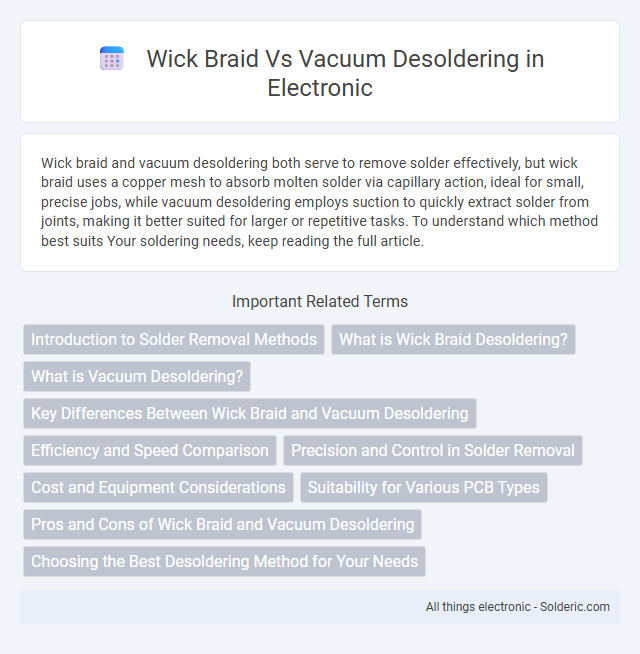Wick braid and vacuum desoldering both serve to remove solder effectively, but wick braid uses a copper mesh to absorb molten solder via capillary action, ideal for small, precise jobs, while vacuum desoldering employs suction to quickly extract solder from joints, making it better suited for larger or repetitive tasks. To understand which method best suits Your soldering needs, keep reading the full article.
Comparison Table
| Feature | Wick Braid | Vacuum Desoldering |
|---|---|---|
| Definition | Copper braid that absorbs molten solder | Tool using suction to remove molten solder |
| Usage | Manual solder removal on PCBs | Efficient suction of solder from pads and through-holes |
| Efficiency | Slower, requires multiple attempts | Faster, removes solder in one suction |
| Precision | Good for small joints but risk of pad lifting | High precision with less damage risk |
| Cost | Economical and reusable copper braid | Higher initial cost; tool maintenance needed |
| Portability | Compact and easy to carry | Requires power source, less portable |
| Best Applications | Small repairs, fine electronics | Bulk solder removal, through-hole components |
Introduction to Solder Removal Methods
Solder removal methods include wick braid and vacuum desoldering, each offering unique advantages for electronic repair and assembly. Wick braid efficiently absorbs molten solder through capillary action, ideal for precision work on small components. Vacuum desoldering uses suction to remove solder quickly and is beneficial for larger areas or multiple pins, enhancing Your efficiency during repairs.
What is Wick Braid Desoldering?
Wick braid desoldering is a technique that uses a fine copper mesh to absorb molten solder from electronic components and circuit boards. The copper braid is placed on the solder joint, and heat is applied with a soldering iron, allowing the solder to be drawn into the braid through capillary action. This method is effective for cleaning solder pads and removing excess solder without damaging delicate components.
What is Vacuum Desoldering?
Vacuum desoldering is a precise solder removal technique that uses a heated vacuum tip to simultaneously melt and extract molten solder from electronic components or circuit boards. This method offers efficient solder removal with minimal risk of damage to delicate components, making it ideal for repair and rework in electronics manufacturing. Compared to wick braid, vacuum desoldering provides faster, cleaner results, especially for removing solder from through-hole and surface-mount device (SMD) joints.
Key Differences Between Wick Braid and Vacuum Desoldering
Wick braid relies on capillary action to absorb molten solder, making it ideal for small-scale or precise desoldering tasks, while vacuum desoldering uses suction to rapidly remove solder, suitable for larger components or bulk desoldering. Wick braid is cost-effective and simple but slower, whereas vacuum desoldering offers efficiency and cleaner results with specialized equipment. Your choice depends on the scale of your project and the level of precision required.
Efficiency and Speed Comparison
Wick braid and vacuum desoldering differ significantly in efficiency and speed when removing solder. Wick braid excels in precision for small joints but often requires multiple passes, slowing the process. Vacuum desoldering quickly removes solder from large pads or through-hole components, making Your repair or assembly task faster and more efficient in high-volume or complex scenarios.
Precision and Control in Solder Removal
Wick braid offers precise solder removal by absorbing excess solder with fine copper strands, ideal for small, delicate components requiring exact control. Vacuum desoldering systems use suction to efficiently extract molten solder from larger joints, providing speed but less tactile feedback. For intricate work, wick braid allows better maneuverability and accuracy, while vacuum tools excel in rapid bulk solder removal.
Cost and Equipment Considerations
Wick braid offers a low-cost, simple desoldering solution requiring only minimal equipment, making it ideal for occasional or budget-conscious users. Vacuum desoldering systems involve higher upfront costs due to specialized pumps and tips but provide faster, more efficient solder removal for frequent or professional use. Choosing between wick braid and vacuum desoldering depends on your budget and how often precise desoldering tasks are needed.
Suitability for Various PCB Types
Wick braid is highly effective for small, densely populated PCBs due to its precision in removing solder from individual joints without damaging nearby components. Vacuum desoldering excels on multi-layer or high-thermal-mass PCBs where rapid, efficient solder removal from multiple pins simultaneously is required. Both methods complement each other, with wick braid preferred for delicate or intricate boards and vacuum desoldering suited for robust, industrial-grade PCBs.
Pros and Cons of Wick Braid and Vacuum Desoldering
Wick braid offers a simple, low-cost solution for removing solder with precision, making it ideal for small components, but it can be time-consuming and less effective for large amounts of solder. Vacuum desoldering excels in efficiently clearing solder from through-hole joints and larger pads, saving time and reducing thermal stress, though it involves higher initial costs and requires maintenance. Your choice depends on the soldering task complexity and budget, balancing ease of use against equipment investment.
Choosing the Best Desoldering Method for Your Needs
Wick braid excels in precision desoldering of small components by efficiently absorbing molten solder through capillary action, making it ideal for delicate electronics repair. Vacuum desoldering offers speed and power in removing solder from larger joints or multiple pins, reducing thermal stress on the board and improving workflow efficiency. Assessing component size, solder volume, and repair complexity helps determine whether wick braid's fine control or vacuum desoldering's robust capability best suits your project requirements.
wick braid vs vacuum desoldering Infographic

 solderic.com
solderic.com